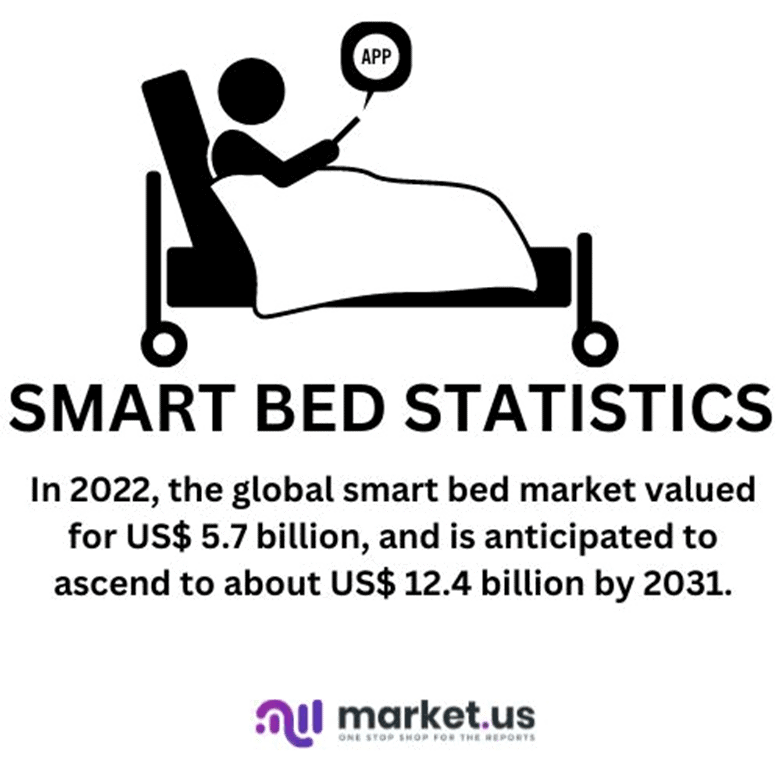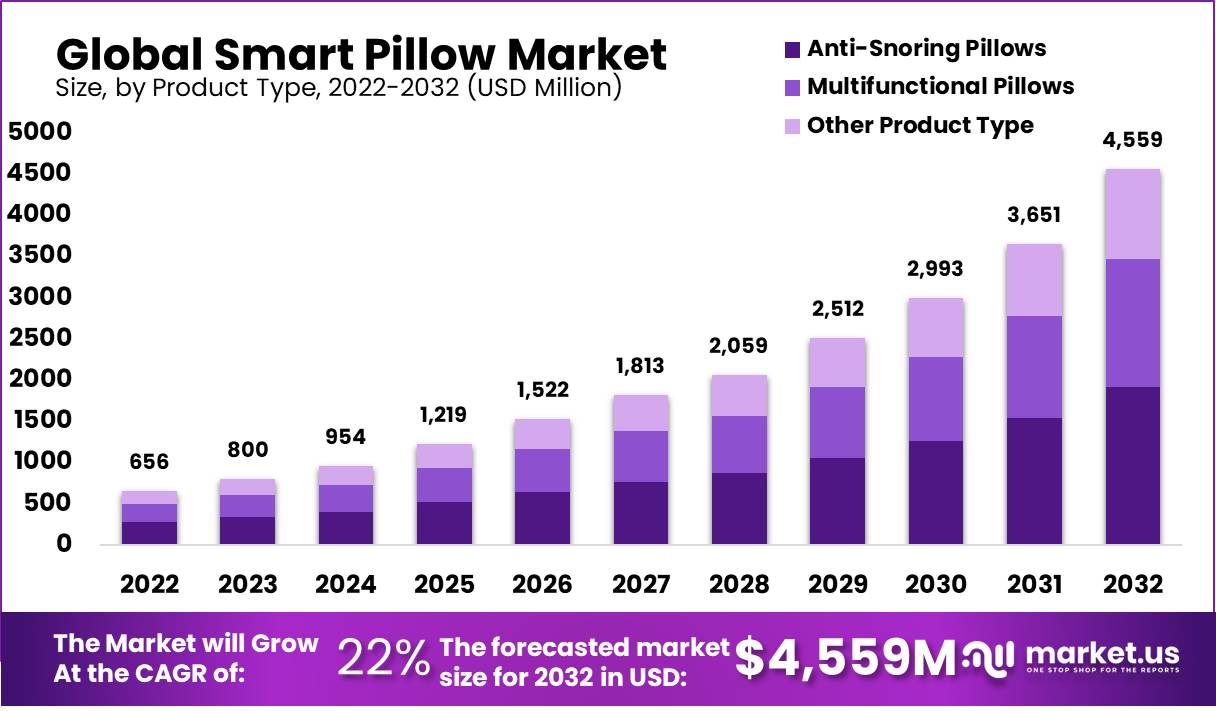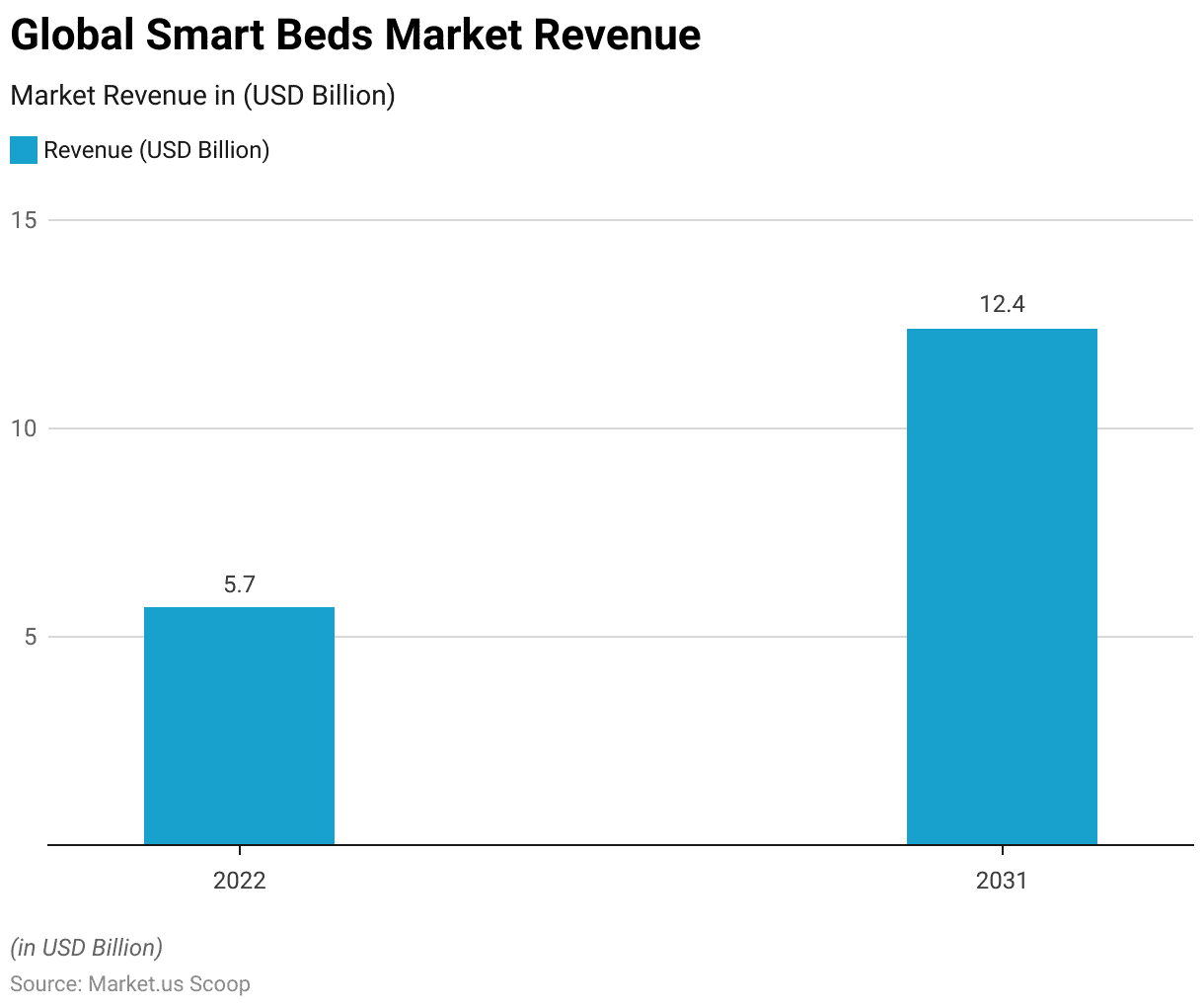Table of Contents
Introduction
Smart Bed Statistics: A smart bed is a technologically advanced and interconnected sleeping platform designed to enhance the sleeping experience by integrating various electronic components and digital functionalities.
Unlike traditional beds, smart beds incorporate sensors, actuators, and communication systems to monitor, analyze, and respond to the user’s preferences, comfort needs, health metrics, and sleep patterns.
These beds are often part of the broader Internet of Things (IoT) ecosystem, enabling them to communicate with other smart devices and platforms within a smart home environment.

Editor’s Choice
- The global smart pillow market size is expected to be worth around USD 4,559 million by 2032 from USD 656 million in 2022, growing at a CAGR of 22% during the forecast period from 2023 to 2032.
- The global bedding industry is projected to reach a valuation of USD 58 billion in 2028.
- In 2022, the worldwide smart bed market attained a valuation of approximately US$ 5.7 billion, and it is anticipated to ascend significantly to about US$ 12.4 billion by 2031.
- Forecasts indicate that the market is poised to display a Compound Annual Growth Rate (CAGR) of 8.7% within the projection period from 2023 to 2031.
- Modern intelligent beds track a comprehensive range of 35 data elements, encompassing the individual’s weight, body temperature, and heartbeat.
- Sleep Number has effectively utilized and gained insights from a vast dataset of over 14 billion hours of sleep data acquired from more than 1.8 billion real-world sleep sessions.
- According to a study conducted in 2014, EarlySense’s monitoring system, positioned both under the mattress and bedside, led to an 86 percent decrease in code blue incidents.
- The research also indicated a 45 percent reduction in the average duration of ICU stays for patients transferred from the medical-surgical unit.

Smart Bed Statistics – Industry Trends
- The global bedding market exhibited a fluctuating pattern over the observed period from 2020 to 2028.
- In 2020, the revenue stood at USD 41 billion, marking the initial point of this timeline. A notable increase was observed the following year, with revenue climbing to USD 46 billion in 2021.
- However, there was a slight dip in 2022, with revenue decreasing to USD 44 billion.
- The trend shifted again in 2023, as revenue experienced a resurgence, reaching USD 47 billion.
- This upward trajectory continued into 2024 and 2025, with revenue reaching USD 49 billion and USD 51 billion, respectively.
- The momentum remained steady over the subsequent years, as revenue gradually rose to USD 53 billion in 2026, USD 56 billion in 2027, and USD 58 billion in 2028. This data underscores the dynamic nature of the bedding market, characterized by alternating periods of growth and minor contractions, ultimately culminating in a consistent expansion in revenue over the years.
(Source: Statista)

Global Smart Bed Market
- In 2022, the worldwide smart bed market attained a valuation of approximately US$ 5.7 billion, and it is anticipated to ascend significantly to about US$ 12.4 billion by 2031.
- Forecasts indicate that the market is poised to display a Compound Annual Growth Rate (CAGR) of 8.7% within the projection period from 2023 to 2031.
(Source: Astute Analytica)

Technology Landscape
IoT Integration in Bedding – Smart Bed Statistics
- The Internet of Things (IoT) can be useful in diagnosing obstructive sleep apnea, breathing, and respiratory disorders.
- According to a recent study using IoT pressure sensors, for infants aged two months to 1 year, a breath count exceeding 50 breaths per minute was observed. Lower breath counts were linked to a condition known as APNEA.
- Children between the ages of 1 and 12 typically have a breath count of over 40 breaths per minute.
- Individuals older than 12 generally exhibit a breath count of more than 20 breaths per minute.
- Modern intelligent beds track a comprehensive range of 35 data elements, encompassing the individual’s weight, body temperature, and heartbeat. Additionally, these beds incorporate sensors for monitoring blood oxygen levels and pressure measurements.
- According to a study conducted in 2014, EarlySense’s monitoring system, positioned both under the mattress and bedside, led to an 86 percent decrease in code blue incidents.
- The research also indicated a 45 percent reduction in the average duration of ICU stays for patients transferred from the medical-surgical unit.
(Source: Wyebot, Science Direct, 2014 Harvard Medical School study)
Sensor and Tracking Technologies
- Sensor and tracking mechanisms is crucial to monitoring sleep issues, and several companies provide efficient smart bed sensors.
- Eight Sleep’s sleeping heart algorithm demonstrates an average error of -0.3 bpm, a mean absolute error of fewer than one beat per minute (bpm), and a mean absolute percent error of 1.5% compared to electrocardiogram (ECG) measurements.
- Similarly, its heart rate variability algorithm showcases a mean percent error of 6.8%, a mean error of -2.5 milliseconds, and a correlation coefficient of 0.90 when pitted against the widely recognized ECG standard.
- Following this, the company introduced a new respiratory rate algorithm in November 2022, which unveiled a mean absolute percent error of 1.9%, a mean absolute error of less than one breath per minute, and a mean error of -0.13 breaths per minute when compared to data collected from a respiratory inductance plethysmography belt.
- The CEO and co-founder of Eight Sleep mentioned that his company is currently working on publishing clinical results in a peer-reviewed journal. These findings indicate notable enhancements in users’ sleep experiences. These enhancements encompass achieving sleep quality improvements of as much as 32%, obtaining up to 34% more deep sleep, and benefiting from an increase of up to 19% in recovery sleep.
- Sleep Number consists of effective sensors, and its users are assigned a SleepIQ score, which rates their sleep quantity and quality on a scale ranging from 10 to 100.
- A score above 85 indicates “exceptional” sleep. Other intelligent beds also furnish comparable data on sleep to their users.
(Source: Eight Sleep and Mount Sinai study, Sleep Number data)
Benefits of Smart Beds
Sleep Monitoring and Analysis – Smart Bed Statistics
- The most beneficial aspect of using a smart bed is monitoring sleep and its subsequent analysis. The findings of a study indicate that the 360 smart bed could offer a dependable and extended way to gauge sleep quality, allowing individuals to access sleep data conveniently from their homes.
- This approach is particularly beneficial for monitoring larger populations over extended timeframes compared to the limitations of traditional PSG (polysomnography).
- Sleep Number has effectively utilized and gained insights from a vast dataset of over 14 billion hours of sleep data acquired from more than 1.8 billion real-world sleep sessions.
- These insights demonstrate that individuals using the 360 smart bed experience an additional 170 hours of restful sleep annually, translating to an average nightly gain of 28 minutes.
- The research involved 45 participants spanning the age range of 22 to 64. These individuals spent a single night in a controlled laboratory environment where they underwent polysomnography (PSG) and SleepIQ recordings concurrently.
(Source: Sensor Journal)
Adjustability and Personalization – Smart Bed Statistics
- The trend of personalized smart beds is gaining momentum, and many manufacturers offer innovative features to these beds while gaining consumers’ attention.
- For example, the Hi Can smart bed incorporates a sizable 70-inch home theatre display. Crafted with various innovative concepts, the Hi Can smart bed is designed to provide the utmost tranquillity and relaxation, resulting in a product-centered around meeting customer preferences.
- The ReST smart bed offers a variety of choices, including the smart bed with a single pump, the smart bed with an integrated pump, the smart bed with five zones, and the smart bed with five zones and geogrid technology.
- The GhostBed features a frame made entirely of 100% steel, boasting a matte finish. It also includes a steel retainer bar designed to secure the mattress in position with a non-slip surface.
- The bed comprises three customizable, modern pieces of charcoal grey fabric cover, providing optimal comfort for work or sleep. The GhostBed accommodates various mattress designs, including memory foam, latex, and hybrid styles, offering flexibility to suit your preferred mattress type.
(Source: JoyofAndroid)
Challenges and Concerns – Smart Bed Statistics
- A recent survey data categorizes the concerns associated with smart bed implementation in healthcare settings.
- The largest category, accounting for 27.1% of responses, pertains to increased workload, including frequent false alarms and heightened inquiries from patients and families.
- Inaccuracy concerns, encompassing issues related to measurement reliability and operational errors, constitute 13.1% of responses.
- Accidents linked to equipment malfunction and inexperienced operation, such as entrapment and medication route errors, represent 12.5% of responses.
- Patient safety issues, including skin damage and falls, comprise 10.3% of concerns.
- Financial aspects, like repair costs and medical bills, account for 8.8% of responses.
- Worries about compromised nursing care quality, technology reliance, and work negligence collectively form 8.5% of the concerns.
- Additional concerns, such as the burden of technology adoption, potential patient discomfort, doubts about usability and effectiveness, and dislikes from patients and families, contribute to the overall landscape of issues.
- Limitations of product use, maintenance, and privacy concerns constitute the remaining 2.0% and 1.2% of concerns, respectively.
- Also, a study raised concerns about the lack of validation, stating that three of the 73 sleep apps reviewed had undergone validation studies employing polysomnography (PSG) for verification.
(Source: Tertiary hospital survey in Gyeonggi Province-South Korea, 2021 Sleep Science Data)
Consumer Opinion
– Age
- The consumer data presented various variables and corresponding statistics based on a recent survey. The participants’ ages ranged from 22 to 52, with a mean of 30.88 years reported usefulness with a standard deviation of 6.19.
– Gender
- Regarding gender, in the case of 4.6% male and 95.4% female, respondents showed moderate to high usefulness.
– Education
- Regarding education, of survey respondents, 3.2% were community college graduates, 79.7% had a bachelor’s degree, and 17.2% had some graduate education. These respondents showed a positive perception.
– Expertise
- The nursing participants with an average clinical experience of 7.64 years, ranging from 0.17 to 30.17 years, showed perceived usefulness and had a mean score of 23.76 with a range of 0 to 28.
- The perceived ease of use had a mean score of 22.72, ranging from 0 to 28.
- The intention to accept the smart bed technology had a mean score of 12.47 with a range of 0 to 14.
– Workload
- Regarding the perceived assistance in workload, the participants’ responses were categorized to different extents. No extent was reported by 0%, low extent by 2.6%, neutral by 9.2%, moderate extent by 41%, and greater extent by 47.3%.
- The overall perceived assistance score was 5.54, with subcategories of physical assistance at 6.78 and mental assistance at 3.77.
- Finally, participants’ perceived necessity of the smart bed technology was categorized as follows: not at all by 0%, slightly by 2.9%, somewhat by 9.5%, moderately by 43.8%, and very much by 43.8%.
(Source: Tertiary hospital survey in Gyeonggi Province, South Korea)
Smart Bed Statistics – Health Implications
- The potential health implications involved in using smart beds can be studied in recent data, which represented D1-all, D2-healthy, D2-INS (Insomnia), D2-RBD (Rapid Eye Movement Behaviour Disorder), D2-PLMD (Periodic Limb Movement Disorder), and D3.
- The study includes 994 subjects, with D1-all consisting of 994 individuals, D2-healthy of 16, D2-INS of 9, D2-RBD of 22, D2-PLMD of 10, and D3 of 45 participants.
- Of the participants, 67.0% were male, and 33.0% were female.
- Male representation was highest in D1-all (67.0%) and D2-RBD (86.4%), while female representation was most prominent in D2-INS (55.6%) and D3 (55.6%).
- The mean age across all subjects was 55.2 years, with variations observed within each group.
- Notably, D2-healthy had a significantly lower mean age of 32.2 years, D2-INS had an older mean age of 60.9 years, D2-RBD had the highest mean age of 70.7 years, D2-PLMD had a mean age of 55.1 years, and D3 had a mean age of 41.2 years.
- The distribution of sleep stages was also examined. The average percentages of light sleep were highest in D1-all (56.4%) and D3 (51.9%), while D2-healthy exhibited lower levels (43.3%).
- The percentages of deep sleep were comparable among the groups. However, D2-INS showed a slightly higher percentage of deep sleep (9.06%).
- Rapid Eye Movement (REM) sleep percentages were notably higher in D2-healthy (38.9%) and D2-RBD (26.7%) groups, whereas D1-all and D2-PLMD had relatively lower percentages.
- Wakeful percentages were divergent among groups, with D2-healthy having the lowest (8.94%) and D2-INS having the highest (36.5%) wakeful percentage. These findings collectively demonstrate variations in sleep patterns and stages among the different subject groups.
(Source: Journal of Physiological Measurement)
Recent Developments
Acquisitions:
- Tempur Sealy’s Acquisition of Mattress Firm: In 2023, Tempur Sealy International announced the acquisition of Mattress Firm, one of the largest mattress retailers in the United States, for $4 billion.
- This strategic move aims to expand Tempur Sealy’s retail footprint and enhance its distribution network for smart bed products.
New Product Launches:
- Sleep Number’s Climate360 Smart Bed: Sleep Number introduced the Climate360 smart bed in 2023. This innovative product features advanced temperature control technology that can adjust the bed’s temperature to help users fall asleep faster and stay asleep longer.
- The bed also includes biometric sensors to monitor sleep quality and provide personalized insights.
Funding:
- Eight Sleep’s Series C Funding: Eight Sleep, a company specializing in smart mattresses and sleep technology, secured $40 million in a Series C funding round led by Valor Equity Partners.
- The funding will be used to further develop their product line, enhance their sleep tracking technology, and expand their market presence.
Market Growth:
- Significant Growth in the Smart Bed Market: The growth is driven by increasing consumer awareness of sleep health, advancements in sleep technology, and the growing demand for personalized sleep solutions.
Innovation in Sleep Technology:
- Integration of AI and IoT: Smart bed manufacturers are increasingly integrating Artificial Intelligence (AI) and Internet of Things (IoT) technologies into their products.
- These innovations allow for real-time sleep monitoring, automatic adjustments based on user preferences, and integration with other smart home devices to create a comprehensive sleep environment.
Strategic Partnerships:
- The partnership between Sleep Number and NFL: Sleep Number continued its partnership with the National Football League (NFL) to provide athletes with smart beds that monitor sleep quality and offer personalized recovery recommendations.
- This collaboration aims to enhance the performance and recovery of NFL players through better sleep.
Conclusion
Smart Bed Statistics – The realm of smart beds has witnessed remarkable advancements and integration of cutting-edge technology to revolutionize the sleep experience.
These intelligent beds are designed to monitor and analyze various sleep metrics, including heart rate, breath count, and movement, contributing to a more comprehensive understanding of sleep quality and patterns.
The market for smart beds has shown consistent growth, with revenue figures steadily increasing over the years.
Integrating IoT technology into bedding has paved the way for personalized sleep solutions, offering adjustable settings, sleep tracking, and connectivity with other smart devices.
This convergence of technology and bedding enhances sleep quality and provides valuable insights into users’ health and wellness.
FAQs
A smart bed is a technologically advanced bedding platform integrated with sensors, connectivity, and data analytics capabilities. It monitors various sleep metrics and offers personalized features for enhanced sleep quality and comfort.
Smart beds can monitor various data, including heart rate, breath count, movement, sleep stages, temperature, etc. This data helps users gain insights into their sleep patterns and health.
The smart bed market has been growing steadily over the years. Revenue figures consistently increase, reflecting the demand for technologically advanced sleep solutions.
Smart beds offer personalized comfort settings, sleep tracking, improved sleep quality, and potential health insights. They can also integrate with other smart devices for a connected sleep environment.
Privacy concerns exist as sleep data collected by smart beds and related apps can be sensitive. There is a potential risk of data breaches, emphasizing the need for robust security measures.
Discuss your needs with our analyst
Please share your requirements with more details so our analyst can check if they can solve your problem(s)



